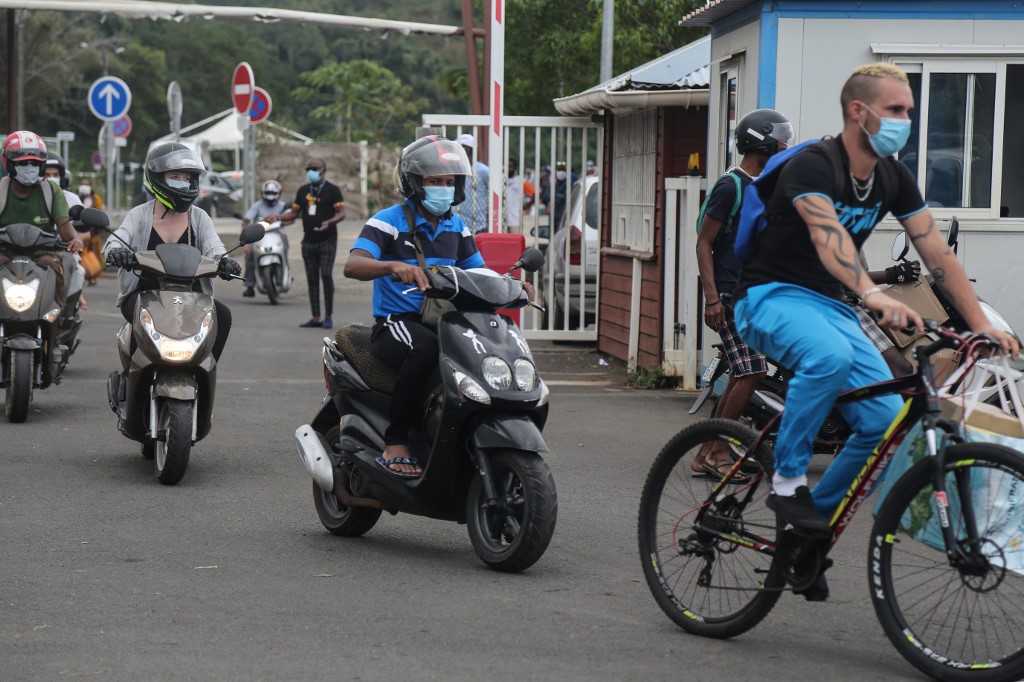
Bike and scooter passengers wearing protective face masks, make their way to board the ferry in Mamoudzou, on the French Indian Ocean island of Mayotte to sail to Petite Terre, on June 4, 2020, as measures to curb the spread of the COVID-19 (novel coronavirus) are maintained on Mayotte over concerns about the continued spread of the virus there and a fragile health system. (Photo by Ali AL-DAHER / AFP)
WASHINGTON, United States — Electric bikes and scooters, dismissed before the pandemic as a curiosity or nuisance, are getting fresh traction in cities seeking new transportation options as they emerge from lockdowns.
Some “micromobility” operators which cut back or shut down during the coronavirus lockdowns are now expanding to meet growing demands.
Shared mobility operators Lime, Bird and Ford-owned Spin report robust growth in cities worldwide, despite a near-shutdown of tourism, as people turn to scooters and e-bikes for commuting or errands.
“People are desperate for open air transportation where they can maintain social distancing,” said David Spielfogel, chief policy officer at Lime, which has relaunched in most of its 100-plus cities.
Spielfogel said city officials have warmed to the idea of micromobility despite a cool attitude just months earlier.
“There has been a sea change in the attitude of cities from seeing micromobility as novelty primarily used by tourists to seeing bikes and scooters as a core piece of the transportation system that will thrive in the post-pandemic period,” he said.
“Cities are afraid that people will return to cars, so they see this as a good option.”
Lime, which has agreed to take over the Uber Jump scooters and bikes, said it has seen “exponential” growth in cities such as Paris, Washington, Tel Aviv, Oklahoma City and Zurich, among others,
Spin recently unveiled plans to launch its shared e-scooters in Cologne and other German cities, and will expand in US cities including Atlanta.
Spin said it had seen weekly usage increases of some 30 percent since April with people using scooters for longer periods.
The scooters “are being used now more than ever as a utility rather than for leisurely activities,” said Euwyn Poon, president and cofounder of Spin.
Global scooter operator Bird also said business is looking up, with North American ridership more than double pre-pandemic levels.
“Around the world, an increasing number of people are trying micromobility for the first time,” Bird said in a blog post.
Shifting gears
In the months before the pandemic, some local officials were decrying dockless bikes and scooters as nuisances creating sidewalk “clutter.”
But the pandemic has changed the outlook, with fear of crowds cutting transit ridership by 70 to 90 percent.
“The pandemic has certainly changed the way communities view micromobility,” said Susan Shaheen, co-director of the Transportation Sustainability Research Center at the University of California at Berkeley.
“Anecdotal evidence suggests that a lot of communities are considering micromobility as an important strategy to maintain social/physical distancing as the economy reopens.”
Traditional bicycling is also experiencing a revival in many urban areas, spurred by new protected lanes which may be used by the small electric vehicles as well.
The pandemic disruption “has created fertile ground” for micromobility, said Annie Chang, head of new mobility for the engineering association SAE International and author of a report on COVID’s impact on transportation.
“I think people have begun to see the value of tiny vehicles and that value will increase as the technology improves.”
Without new options, she noted, many cities could see a rise in auto traffic and congestion.
Finding an economic model
Harriet Tregoning, director of the Numo Alliance, a nonprofit group focused on urban mobility, said the economic model for shared micromobility firms remains murky.
Venture-funded firms which cater to tourists and college campuses may only marginally help with post-COVID transportation needs, she said.
These services have more value if integrated into transportation systems, Tregoning said.
This could be done in coordination with transit agencies to help reach underserved areas, with the possibility of public or employer subsidies for “bundled” subscriptions.
Tregoning said micromobility can become a more important element if cities invest and coordinate with transportation agencies.
“Cities need to invest in bikesharing and create a strategic relationship to transit,” she said.
Technology analyst Richard Windsor said e-bikes “are a good replacement for public transportation because the motor assistance makes the commute much easier for those that are less fit or do not want to arrive at the office drenched in sweat.”
But Windsor writes on his Radio Free Mobile blog that the trend “points towards a user preference towards ownership and away from sharing.”

